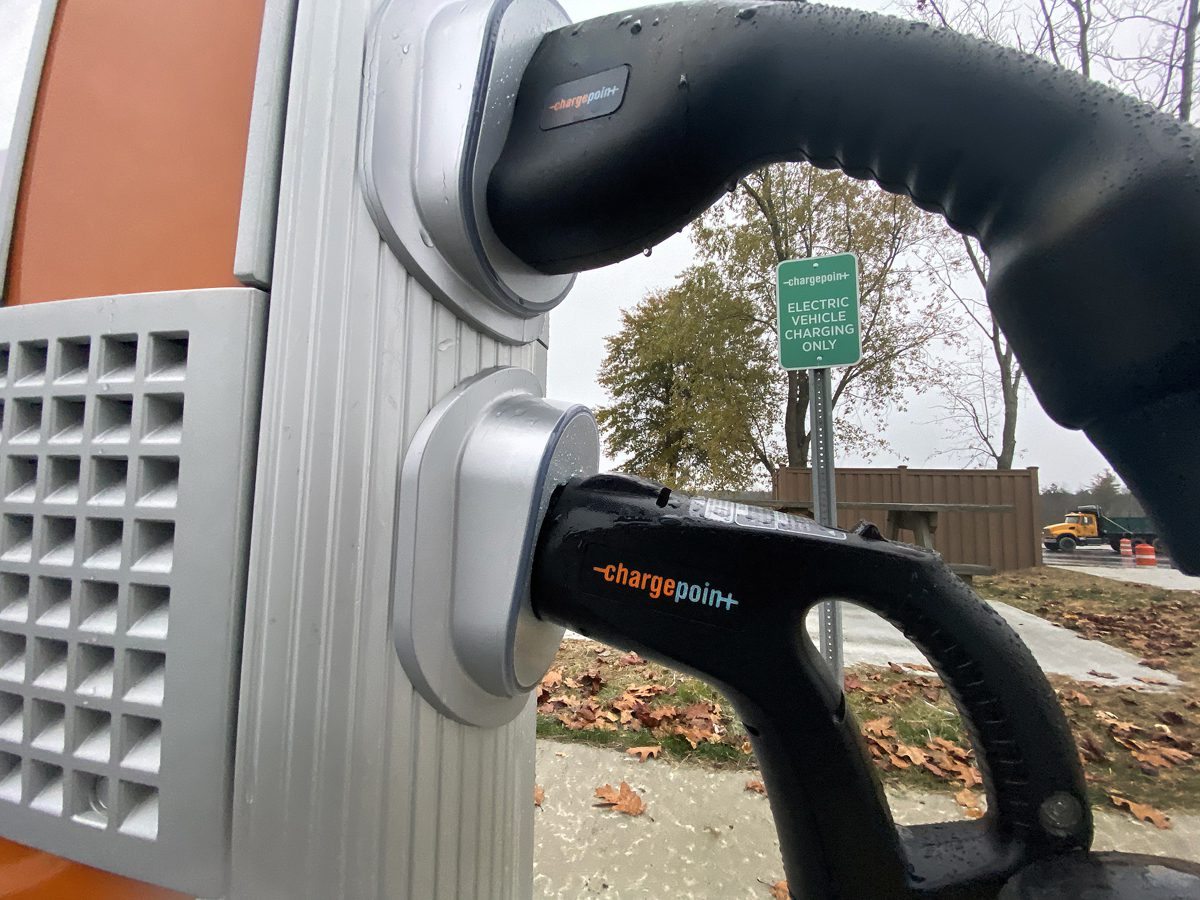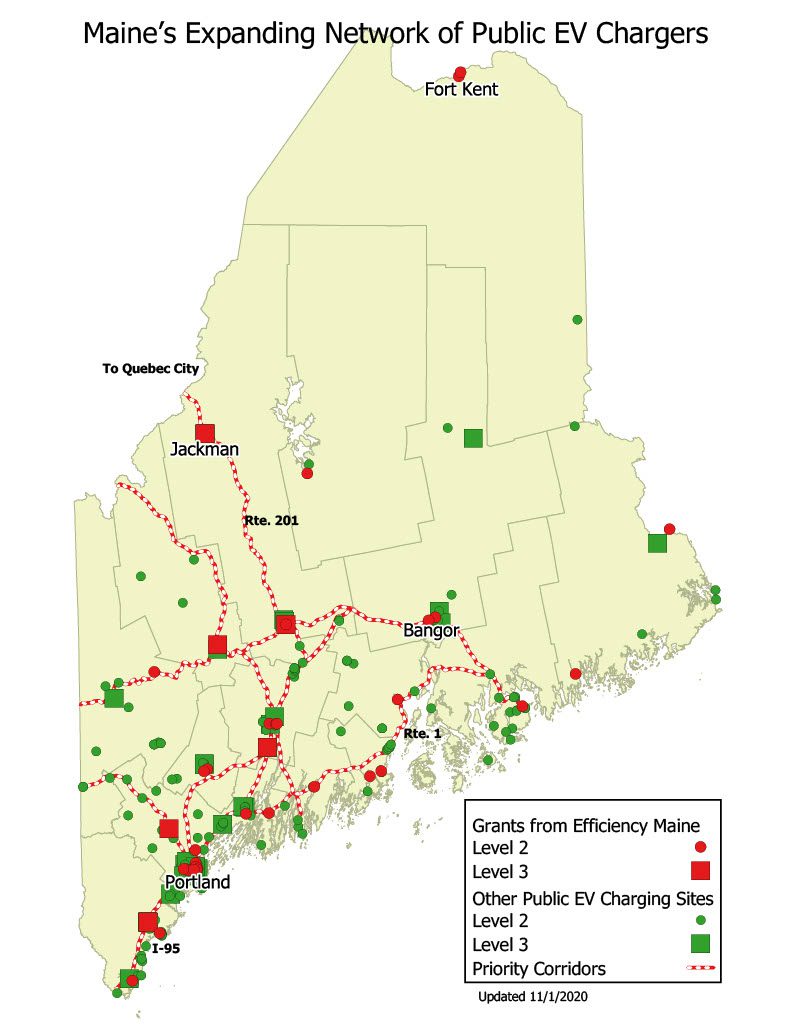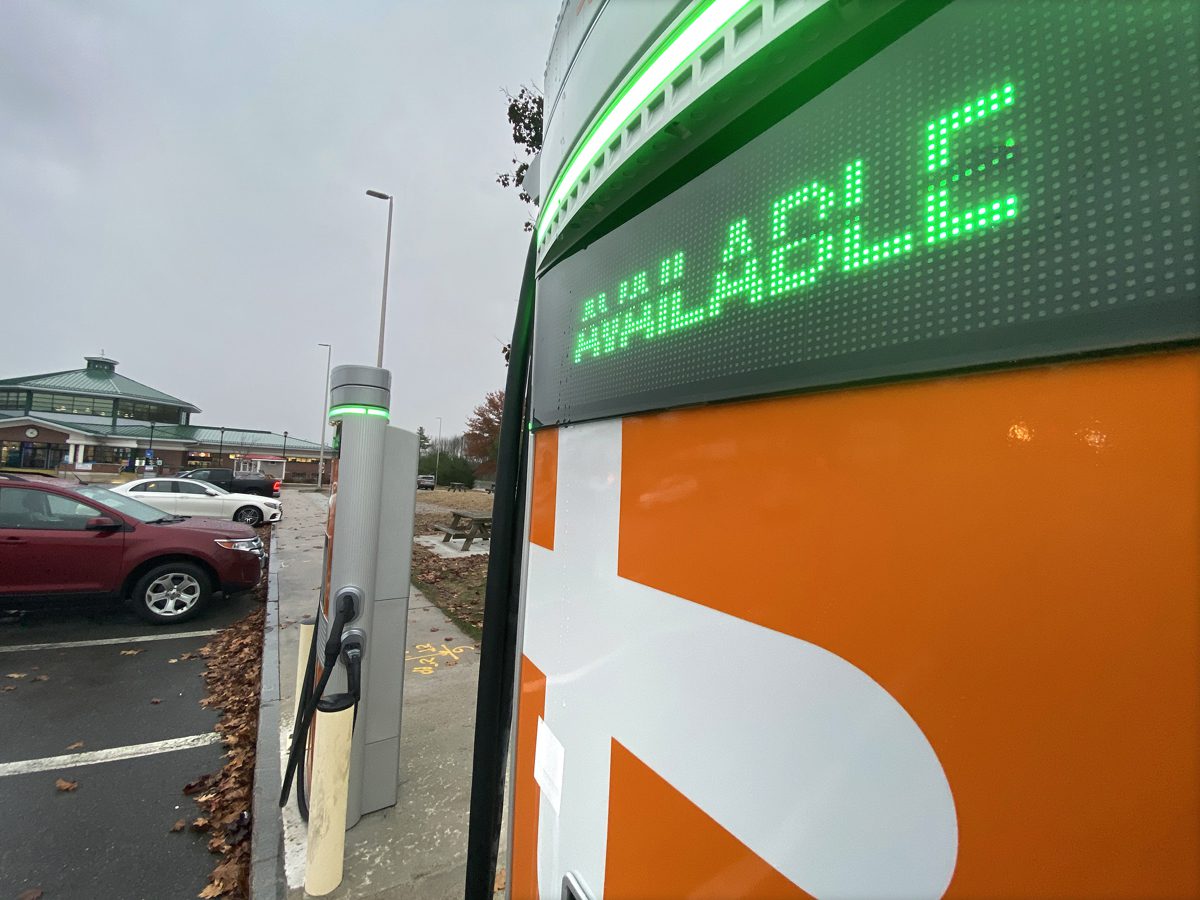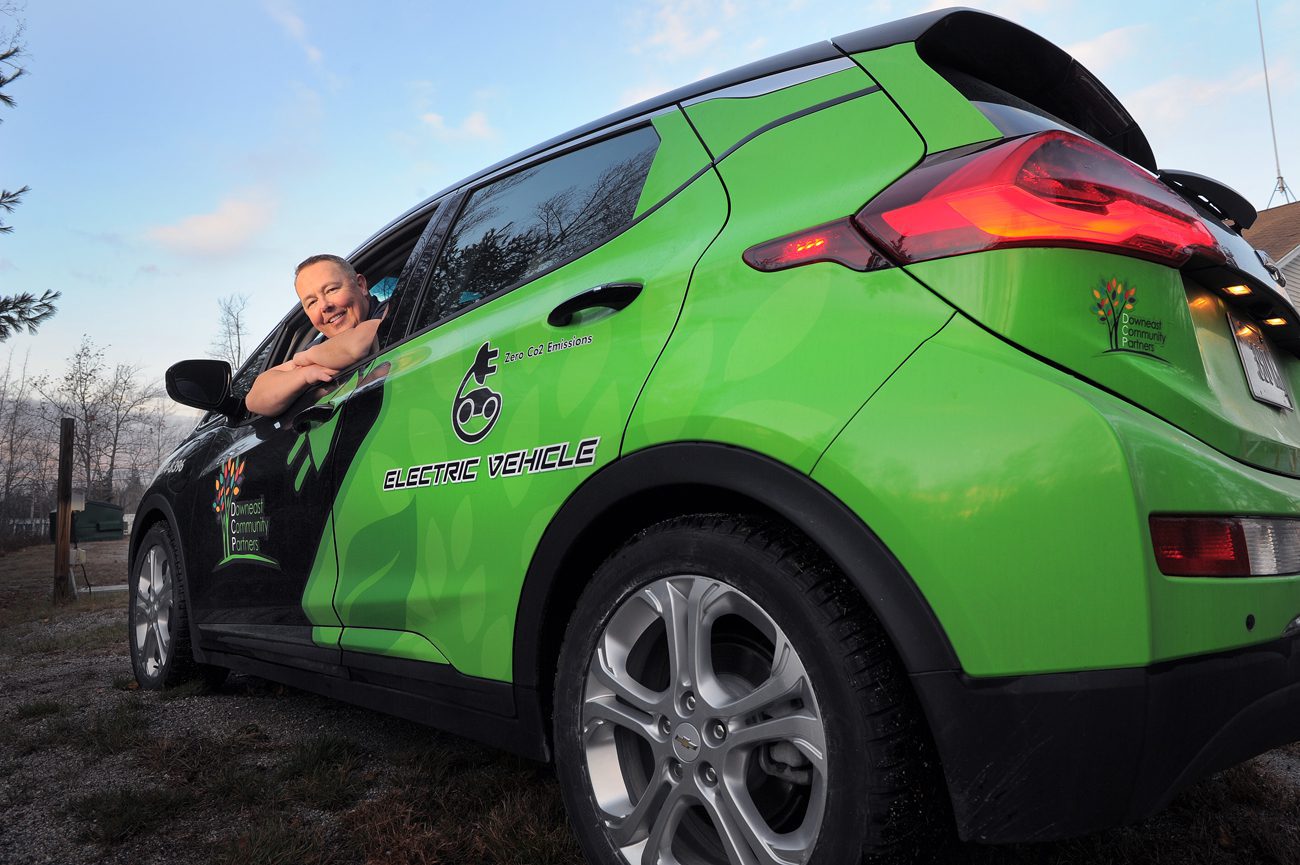This article was produced in partnership with the Energy News Network, a nonprofit news site that covers the transition to a clean energy economy from state and regional perspectives.
Only 1 percent of vehicles sold in Maine are electric, yet a few of those cars are already traveling the back roads and dirt driveways of Hancock and Washington counties. When the nonprofit agency Downeast Community Partners (DCP) delivers food, it’s likely to be in a battery-powered Chevy Bolt.
As part of its mission to help “improve the quality of life and reduce the impact of poverty in Downeast communities,” DCP uses three all-electric Bolts, powered by solar energy and charged at publicly accessible stations near its offices. Dale Basher, DCP’s housing operations manager, wants area residents to experience the many benefits of electric cars.
“A lot of people are skeptical, but they’re an incredible vehicle,” he said.
Electrifying transportation with solar power, Basher believes, could ease long-term cost burdens on the region’s residents. While acknowledging hurdles to widespread electric vehicle adoption, he’s optimistic that improvements in batteries will hasten the transition.
“We’re seeing the progression happen,” he said. “It’s changing so fast.”
Technology is advancing more rapidly than policy supports for vehicle electrification, but Maine’s clean energy law could force the latter to catch up. Transportation accounts for 54 percent of Maine’s greenhouse gas emissions, with light-duty cars and trucks contributing the most.
Reaching state targets for reduced emissions will require that somewhere between half and 90 percent of cars and light-duty trucks on the road be electric by 2050. Other states are moving even faster; California is banning sales of new gas-powered passenger cars and trucks beginning in 2035, and New Jersey may follow.
Being the oldest and most rural state, Maine faces added hurdles. Its Climate Action Plan, being finalized this fall, could help guide policy-makers as they seek ways to have EVs benefit those with the greatest need.
The promise of long-term economic gains
Transportation drains $13,500 annually from the average Maine household, roughly 30 percent of income, according to the Maine Climate Council. For low-income households, transportation spending can reach 40 percent of income. Rural drivers tend to have higher fuel and repair costs because they log 72 percent of the vehicle miles traveled each year in Maine.

Nationally, rural households have lower average incomes yet often spend 7 percent more for transportation than urban dwellers.
While electric vehicles cost more than comparable gasoline-powered models to purchase, they require roughly half as much to fuel and maintain. A 2018 analysis of data from the Northeast and Mid-Atlantic found that rural residents who replaced conventional vehicles with electric vehicles could save $870 per year, up to twice as much as urban residents.
As battery costs fall, the price of electric vehicles is dropping relative to comparable conventional vehicles. A research team at Carnegie Mellon predicts that at least the basic car models will cost about the same as gas-powered models sometime between 2023 and 2025.
The economic impact of widespread electric vehicle adoption could be significant for Maine because the roughly $2.5 billion spent annually fueling vehicles largely goes out of state. Decreased gasoline expenditures would leave more money circulating locally. A recent analysis in the Northwest found that each electric vehicle adopted through 2030 would add roughly $4,100 to the regional economy.
Formidable short-term challenges
For Maine to realize those gains, it will need an extensive network of charging stations – both Level 3 (DC Fast) chargers and slower Level 2 chargers.
Using Volkswagen settlement funds, Efficiency Maine has helped install about 100 Level 2 chargers and has what Michael Stoddard, its executive director, calls “the beginnings of a decent foundation for a Level 3 network” north to Bangor and east to Ellsworth. Private businesses have installed many Level 2 chargers as well.

But large swaths of rural Maine remain charging deserts, overlooked by commercial installers due to low population density. In the absence of adequately spaced chargers, battery range can be a concern, particularly when it’s reduced by cold temperatures or highway speeds.
The closest Level 3 charger to DCP’s office in Ellsworth is about 80 miles away. Level 2 chargers are more common but provide only about 25 miles of range per hour of charge – making it critical, Basher said, “to plan your trips accordingly.”
As battery technology improves and charging infrastructure expands over the next few years, range anxiety may become less of a concern, Stoddard said.
A bigger impediment for rural residents in the short term could be limited model options. Many new models are in development, including electric pickup trucks, but few right now have all-wheel-drive capacity or the clearance and suspension systems needed in some rural settings. Getting a “wider range of vehicle type will be a game-changer,” said Jonathan Rubin, a University of Maine economist who chairs the environment and energy section of the National Academies’ Transportation Research Board.
Maine residents are highly reliant on personal vehicles, given limited public transit; 72 percent of Mainers over age 65 live in a community with no fixed or flex-route transportation. More than a tenth of the state’s population is over age 75 and while most of those older residents still drive, said Jess Maurer, executive director of the Maine Council on Aging and a member of the Maine Climate Council Transportation Working Group, Maine could face “a crisis” when they stop driving and need transportation services that don’t exist.
Maurer hopes that some communities will start considering ways to share electrified passenger vans. She envisions school districts in all but the state’s largest urban areas “phasing out the long yellow buses” and opting for medium-duty vans that could serve schools but also meet public transit needs, potentially through an on-demand van service. Microtransit options are getting more efficient and user-friendly, but typically require ready access to broadband, which much of rural Maine lacks.
Many public comments on the Maine Climate Council’s draft transportation strategies expressed what staff characterized as “rural skepticism” about whether electrical vehicles and public transit options could work in remote settings where people drive long distances and often buy used vehicles.
Electrifying transportation equitably
Despite the long-term savings electric vehicles offer, their higher up-front cost remains a deterrent. Federal tax credits are available on some models but may not benefit lower-income households with little or no tax liability. One study found that 90 percent of electric vehicle-related tax credits taken since 2006 went to the top 20 percent of earners.
To counteract that bias, an equity analysis of Maine’s draft climate strategies concluded that “financial incentive programs must be explicitly targeted at those who need financial assistance most.”
In August 2019, Efficiency Maine launched an “EV Accelerator” rebate program that – in its first year – provided instant rebates on 600 vehicles, offering buyers $2,000 at purchase on fully electric vehicles and $1,000 on plug-in hybrids, with an additional $500 to 1,000 for qualified low-income residents.
A review of the program’s initial year is underway, but one conclusion is clear. The rebate was “not a sufficient incentive to make these (EVs) attractive to low-income customers,” Stoddard said; they received “only 2 or 3” of the 600 rebates.
To simplify income verification, Efficiency Maine chose to narrow the pool of potential applicants to those in the Low-income Home Energy Assistance Program – households with the lowest incomes and high heating costs. Other states have allowed applicants from a broader range of assistance programs or simply let them self-certify on income.
Low-income residents typically buy used vehicles priced under $10,000, so states need to provide incentives for that market, the Maine Climate Council Transportation Working Group acknowledged in its draft strategies, urging the state to extend rebates to used vehicles and e-bikes.

Two-thirds of vehicle sales nationally involve used models, said Rubin, the UMaine economist, and Maine is “at least at the national average.” While there are “administrative complexities” with used-car rebates and more careful planning is needed so “people don’t game the system,” he said, Maine has the best chance of realizing its climate targets if “everyone participates in getting a better, cleaner car.”
California offers lower-income residents rebates to scrap older, inefficient vehicles and additional rebates to acquire a more efficient used vehicle or buy into other options, like transit passes. To direct rebates toward those with the greatest need, California restricts eligibility to low- and moderate-income households.
Vermont is piloting a MileageSmart program that offers rebates of up to $5,000 for low-income residents to purchase a used hybrid or electric vehicle with a documented MPG of more than 40 miles per gallon. With a first-year appropriation of just $750,000 from the Vermont Legislature, the pilot is set up to minimize staffing demands, acting largely “like an online shopping experience,” said Paul Zabriskie, the weatherization and climate impact director at Capstone Community Action in Vermont.
Zabriskie doesn’t expect all the drivers of gas-guzzling pickup trucks or SUVs to opt for an approved electric model, knowing that decades of advertising have ensured “a tremendous amount of personal identity is tied up in your vehicle.” But the incentives are there for those ready to admit that a “smaller vehicle will provide the services we need, maybe not the image we want.”
While Vermont and California limit rebate offers to EVs, Maine could consider providing incentives on highly efficient gas models as a temporary measure “to improve the overall efficiency of the fleet,” said David Costello, the climate and clean energy director for the Natural Resources Council of Maine.
Alternative financing options are also key, Zabriskie said, given how many low-income residents can’t get conventional financing. Basher advocates for a loan program like the Maine State Housing Authority heat pump program – participants get a heat pump with no money down, paying over time through the savings delivered by that more efficient technology.
To create a self-funding incentive system, Vermont has proposed a “feebate” that would use fees placed on the purchase of new, high-emissions vehicles to help fund rebates on electric and hybrid cars. This model, used in France, led to a 6 percent drop in emissions in the first year. Having “one set of consumers cross-subsidizing another set of consumers” is a promising, revenue-neutral approach, Rubin said, while acknowledging it can be a “challenge to implement politically.”
The need for strategic coordination
“Transportation policy has been set up to have winners and losers,” said Angela Johnson-Rodriguez, the statewide organizing director at Transportation for Massachusetts, in a webinar for Mainers last June. Keeping rural areas from being short-changed, she added, takes statewide coordination.
As communities and businesses start to install electrical vehicle chargers, those local initiatives need to fit within a strategic, regional vision. There’s “a real need for holistic thinking,” Rubin said, something he hopes will come from the “EV Roadmap” proposed in the Maine Climate Council’s draft plan outline.
Transportation policy has been set up to have winners and losers.”
— Angela Johnson-Rodriguez, statewide organizing director for Transportation for Massachusetts
The substance and timeline of that Roadmap have yet to be determined, said Dan Burgess, director of the Governor’s Energy Office, but staff are already reviewing models like one in Connecticut that looked at diverse facets of electrifying transportation, including charging infrastructure, utility integration, consumer education, and regulations and policies that would promote transportation equity.
Support for greater equity could come in part through action at the state’s Public Utilities Commission, said Rob Wood, director of government relations and climate policy at The Nature Conservancy in Maine and member of the Maine Climate Council Transportation Working Group. The PUC, for example, could direct utilities to install more charging infrastructure in underserved areas.
Maine’s two major investor-owned utilities have helped install some Level 2 chargers and Central Maine Power Co. is doing preparatory electric work for 60 more. The PUC recently approved a CMP proposal to provide lower off-peak rates at some Level 3 chargers as well.
While these efforts are helpful, Costello said, “CMP has not been as good a partner as it could be in developing strategies that would be beneficial for the state.”
Utilities outside Maine are working to accelerate the transition to electric vehicles, like the Gunnison County Electrical Association, which serves a large, rural region in Colorado. A member-owned cooperative, the Association offers time-of-use rates for overnight car-charging and provides members with rebates on home chargers. It also runs a popular, free “EV loaner” program so members can assess whether an electric vehicle would fit their lifestyle.
As Maine moves forward with implementing its Climate Action Plan, it will be critical to have policies aligned, “not tacked up in isolation” said Benjamin Lake, a transportation efficiency consultant with the nonprofit energy organization VEIC. He noted that the Legislature has begun discussing how to have electric vehicle owners pay a fair proportion for road maintenance, while rewarding owners for the collective benefits those vehicles provide – minimizing road wear through their lighter weight, improving air quality and reducing greenhouse gas emissions.
Electrifying transportation hinges on finding adequate funding, a particular challenge given the pandemic’s impact on state revenues. The most talked-about possibility is the regional Transportation and Climate Initiative (TCI), which would apply a “cap and invest” approach – modeled after the successful Regional Greenhouse Gas Initiative – to prime suppliers of refined oil, and would use the funds generated to increase transportation efficiency.
TCI will not launch until 2022, and Joyce Taylor, chief engineer at the Maine Department of Transportation and co-chair of the MCC Transportation Working Group, said the state is following the discussions closely; “we have a seat at the table and are looking to see what the Memorandum (of Understanding) looks like.” Pre-pandemic modeling showed that TCI would result in a surcharge of 5 to 17 cents per gallon while raising roughly $150 million a year for Maine to invest in transportation upgrades and infrastructure.
“Revenues would directly address equity,” Wood said, adding “that is front and center” for the Initiative’s supporters. Other funding sources may materialize as the Legislature discusses the Climate Action Plan next year, but for transportation, Taylor said, “TCI is the only game in town now.”







